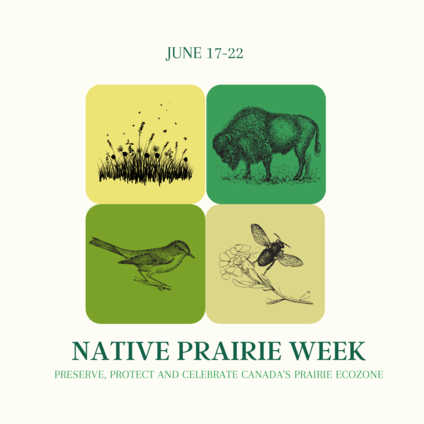
Native Prairie Appreciation Week is officially celebrated in Saskatchewan from June 13-19 in collaboration with the Saskatchewan Prairie Conservation Action Plan (SK PCAP). It is celebrated nationwide from June 17-22. However, the Canadian prairies boast many incredible ecoregions, unique wildlife and stunning landscapes that should be celebrated all the time!
Canada’s Prairie Ecozone extends from central Alberta, through central Saskatchewan and over into southern Manitoba, encompassing a total of 1,780,650.6 km² and is comprised of eight different ecoregions, These ecoregions include Aspen Parkland, Moist Mixed Grasslands, Fescue Grasslands, Mixed Grasslands, Cypress Uplands, Aspen Parkland, Lake Manitoba Plain, and Boreal Transition.
Each of these ecoregions plays a significant role in the function of the greater Prairie Ecozone, where many threatened, endangered, and essential species inhabit and call home. Due to the advancements and expansions in agriculture throughout the country, and more specifically throughout the prairie regions, the amount of true native prairie remaining is far from what it used to be, making it one of the world’s most endangered ecosystems. Of the Saskatchewan prairies alone, only 13.7% of historical grassland coverage remains. This number, while only from 2018, stands outdated and is an under-representation of the true quantity of native prairie that actually remains.
Despite the threats against the remaining native prairie, the Prairie Ecozone is home to some incredible migratory and non-migratory wildlife species including the Pronghorn Antelope, the second-fastest land mammal on earth (second only to the cheetah), the Plains Bison, Swift Fox, Black Bear, Whitetail Deer, Mule Deer, Elk, Moose, White-tailed Jack Rabbit, the Beaver, and many more! The prairies also boast prime habitat for essential and keystone avian species including the Peregrine Falcon, another record-breaking species for the fastest bird on earth, the Swainson’s hawk, Burrowing Owls, Ruby-Throated Hummingbird, Lark Sparrow, Sharp-tailed Grouse, Yellow-Shafted Northern Flicker, Western Meadowlark, Bobolink, Great Blue Heron, Piping Plover, Whooping Crane and the Canada Goose.
Despite being home to many unique native species, the Prairie Ecozone is home to a disproportionate number of endangered species that rely on the prairie ecoregions for habitat, breeding grounds, and stop-over sites, compared to the size of the prairies itself. These species include the Piping Plover, Whooping Crane, Sharp-tailed Grouse, Peregrine Falcon, Mountain Plover, Burrowing Owl and Eskimo Curlew. The various ecosystems encompassed by the Canadian Prairies serve as suitable habitats for these species, but are slowly becoming scarce and threatened due to land degradation from agriculture and urbanization.
The prairies contain many essential wetlands nested within its vast expanses of land, that play a large role in supporting fish, waterfowl, and other avian populations through migratory events, and stop-overs. These wetlands also have a large role in the circulation of vital nutrients to, from and between different environments. The Prairie Pothole Region, a topic we will cover in a later blog post, is encompassed within the Prairie Ecozone and is a vital collection of thousands of shallow wetlands that provide essential habitat and resources for thousands of migratory and native species. Another important and necessary function of the Canadian Prairies that is threatened by increased agricultural land use, urbanization and human interference.
The prairies are also home to many important Indigenous communities that play an integral part in the conservation and preservation of Canada’s prairie ecosystem. The Plains is traditional territory to various nations including, Siksika, Piikani, Kainai, Dakota, Stoney Nakoda, Cree, Assiniboine, and Tsuut-ina. Saskatchewan is known as the Homeland of the Métis while also traditional territory of Cree, Assiniboine, Saulteaux, Lakota, Dene and Dakota. Many of the plant species found on the prairies play an important part in traditional Indigenous medicines such as the use of coneflower for the treatment of headaches, toothaches, and bug bites/stings that have helped to develop current knowledge and understandings of medicinal practices in today's western medicine.
It is for these reasons, that the celebration of the people, the wildlife, and the landscape itself, should encompass more than just a week in the eyes of Canadian citizens. Native Prairie should be celebrated and honoured daily, for the life we sustain here in the prairies is integral to the function of many other interconnected ecosystems and thus deserves to be protected.
To learn more about the Canadian Prairie Ecozone and its many ecoregions, check out the following websites for more in-depth coverage of the communities, wildlife, vegetation and history within this vital and endangered Canadian ecosystem.
More Resources:
Plains Indigenous Peoples in Canada | The Canadian Encyclopedia
The state of native prairie in Saskatchewan – prairiecommons.ca
Canadian Biodiversity: Ecozones: Prairies (mcgill.ca)
Prairie Pothole Region — Ducks Unlimited Canada
NCC: Why Canada’s prairies are the world’s most endangered ecosystem (natureconservancy.ca)
Saskatchewan Prairie Conservation Action Plan (SK PCAP) (pcap-sk.org)
